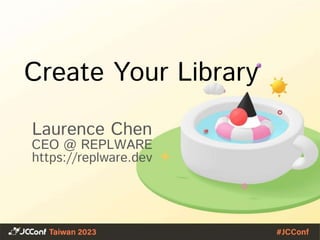Create your library
•Download as PPTX, PDF•
0 likes•87 views
Software developers are always using libraries developed by others. The functions of the libraries are from string processing to task queues. Have you ever considered developing your own software library? This talk is to discuss some issues related to "developing software libraries": 1. What are the benefits of developing a library? 2. What are the usual differences between library and non-library code? Have you heard of mechanism code vs policy code? 3. What are the characteristics of a good library? 4. Where can you easily find opportunities to develop libraries? How to start?
Report
Share
Report
Share

Recommended
Recommended
More Related Content
Similar to Create your library
Similar to Create your library (20)
Your first 5 PHP design patterns - ThatConference 2012

Your first 5 PHP design patterns - ThatConference 2012
Building Better FLOSS Community Relationships @ FB

Building Better FLOSS Community Relationships @ FB
Python For All | Software Professionals, QA & DevOps professionals

Python For All | Software Professionals, QA & DevOps professionals
More from Laurence Chen
More from Laurence Chen (7)
Recently uploaded
Recently uploaded (20)
WSO2 Micro Integrator for Enterprise Integration in a Decentralized, Microser...

WSO2 Micro Integrator for Enterprise Integration in a Decentralized, Microser...
"I see eyes in my soup": How Delivery Hero implemented the safety system for ...

"I see eyes in my soup": How Delivery Hero implemented the safety system for ...
Less Is More: Utilizing Ballerina to Architect a Cloud Data Platform

Less Is More: Utilizing Ballerina to Architect a Cloud Data Platform
Cloud Frontiers: A Deep Dive into Serverless Spatial Data and FME

Cloud Frontiers: A Deep Dive into Serverless Spatial Data and FME
ChatGPT and Beyond - Elevating DevOps Productivity

ChatGPT and Beyond - Elevating DevOps Productivity
The Zero-ETL Approach: Enhancing Data Agility and Insight

The Zero-ETL Approach: Enhancing Data Agility and Insight
API Governance and Monetization - The evolution of API governance

API Governance and Monetization - The evolution of API governance
Navigating Identity and Access Management in the Modern Enterprise

Navigating Identity and Access Management in the Modern Enterprise
Introduction to Multilingual Retrieval Augmented Generation (RAG)

Introduction to Multilingual Retrieval Augmented Generation (RAG)
Design and Development of a Provenance Capture Platform for Data Science

Design and Development of a Provenance Capture Platform for Data Science
Finding Java's Hidden Performance Traps @ DevoxxUK 2024

Finding Java's Hidden Performance Traps @ DevoxxUK 2024
TrustArc Webinar - Unified Trust Center for Privacy, Security, Compliance, an...

TrustArc Webinar - Unified Trust Center for Privacy, Security, Compliance, an...
Choreo: Empowering the Future of Enterprise Software Engineering

Choreo: Empowering the Future of Enterprise Software Engineering
Create your library
- 1. Create Your Library Laurence Chen CEO @ REPLWARE https://replware.dev
- 2. About Me ● Clojure community organizer ● IT Consultant, speaker, writer ● https://leanpub.com/errors_to_innovation/ ( 從錯誤到創新) 2
- 3. Agenda 1. Why should you consider to create libraries? 2. Policy vs Mechanism 3. What are the properties that a good library usually has? 4. How to start? Where to start? The end?
- 4. 1. Why should you consider to create libraries? ● The key to fast development iteration, low error rate and long-term maintainability. ● Why? ○ It reduces cognitive load and manual work for people who use the library. ● Side effects: ○ A good way to separate the source code repository (team works) ○ Your ego and fame (The most important thing!) 4
- 5. Why? language oriented diagram 5
- 6. Library and git repo (code splitting) Each library has its own repo. 6
- 7. Your fame and ego ● Do not need to prepare for the white boards. ● Enjoy being a distinguished engineer. ● Have friends (actually users) all around the world.
- 8. 2. Policy vs Mechanism (Non- library vs library code) 8
- 9. 9
- 10. 3. Properties of a good library ● Provide solution for mechanism ● Documentation ○ Rationale ○ Usage example ● Tests ● Change logs ● No breaking changes after version 1.0. 10
- 11. 4. How to start? Where to start? The end? ● Build up your expertise. ● Find the incongruity. ● Make the library looks like certain part of your programming lang. Extend your tools.
- 12. Build up your expertise ● Start from reading into the library you are using now. ○ It is just one level higher than you. ○ Can you Jump to definition through your IDE or editor? ● Choose better library. ○ Avoid the red flags. For example, huge dependency for little benefits. 12
- 14. Find the incongruity ● Compare different programming language ● Focus on incongruity: ○ The existing solution is not as good as similar thing on other domains. ○ The existing solution to the problem looks like a work around.
- 15. Incongruity from comparing programming lang 15
- 16. The bottleneck of a workflow 16
- 17. Extend your tools ● Example of extensible systems: ○ Lisp - Lisp macro ○ Java - Object & Polymorphism ○ Postgres - user defined function, user defined types ● Is your editor extensible? ○ Can you automate certain things by using your editor’s command? ○ vim - integrate shell’s filtering command ● Is your programming language extensible? ○ Does it allow Lisp macro? (meta programming) ○ Does it provide polymorphism mechanism? 17
- 18. 18
- 19. 19
- 20. Conclusion ● Create your own library for productivity. ● Mechanism vs Policy ● Build up your expertise by reading into libraries. ● From incongruity comes the innovation. ● Extend your tools.
- 21. Reference ● JetBrains: Language Oriented Programming: The next programming paradigm. ● Mechanism vs Policy https://lambdaisland.com/blog/2022-03-10- mechanism-vs-policy ● Leveling up https://lambdaisland.com/p/leveling-up
